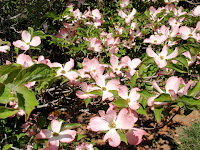I am no expert at identifying the many different eucalypts around Australia, and do not want to bang on forever about trees.

However, in the course of the TSSS I took early morning walks before the heat of the day and enjoyed discovering unknown territories like Glebe and Annandale. The density and maturity of the housing in these inner suburbs renders the discovery of a little park or open green space a particularly delightful surprise. [The little house shown is actually blessed with more than average elbow room, many houses being narrow-fronted attached terraces in various states ranging from sad disrepair to proud renaissance - pardon the additional reference.]
Actually, I lied. I have previously explored Annandale to some extent as a potential terrorist but don't remember much other than one bathroom. I must have been 5 or 6; we were still living in Mosman in a nice half-house in Central Avenue with the black baby grand with a cracked sounding board - surely everyone does that? I went to stay for a day or so with a cousin in (the plot thickens) Annandale.
When time came for an evening bath, I was given instructions on the plumbing and ventured into the forbidding world of the old bathroom. A mysterious rusted gas heater with a bewildering array of pipes and pilots, vents and valves, glared down at me from the wall above a chipped enamel bath with lion's feet. One eye on the heater's frowning presence, I struggled in rising panic to get the hot water flowing, but in vain. In fear of retribution I went out to my aunt to seek further advice, to be met not by scolding but by a look of horror, followed by the rapidly disappearing rear view of aunt as she rushed towards the bathroom. The gas was flowing merrily but the malevolent heater had chosen not to light, or maybe I had not lit it, and I had almost succeeded in blowing up the house and half of Annandale. The memory of an event of such stark terror to a small boy is inevitably a dominant one, so you will surely forgive a suppressed remembrance of its suburban setting.

Back in modern Sydney musing on these events in the distant past, I turned a corner and peeked across a fence: I was delighted to see a stand of tall trees in a college grounds, proud and peaceful amid the traffic noise and heat. Having in a previous blog mentioned the spotted gum, I could hardly resist including this little snapshot. They are surely spotted gums, if not technically Spotted Gum - good on them anyway.
Although the occasional root sweeping up on an angle at the base of the trunk is visible, such as at left foreground, on the whole many species of eucalypt emerge straight from the ground, maintaining an only slightly reducing diameter as they climb. An impression that they are cylinders or poles just standing on the landscape creeps up on you. Several Australian painters (Arthur Boyd, Fred Williams) have picked this up and represented such trees with a single straight brush-stroke.






























